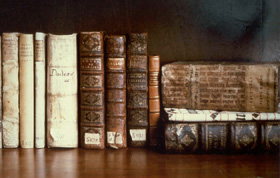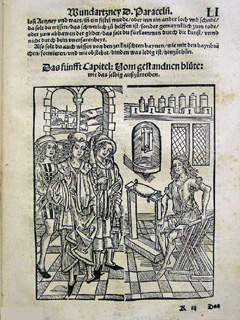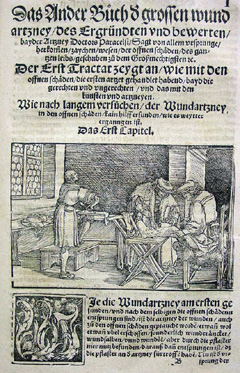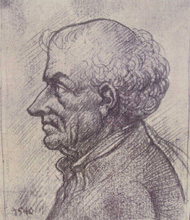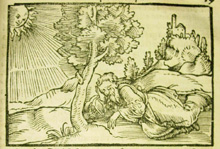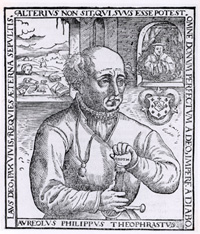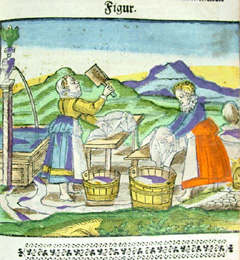The Robert E. Schlueter – Paracelsus Collection
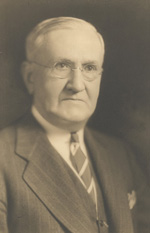 |
| Robert E. Schlueter |
Robert E. Schlueter (1872-1955) graduated from the St. Louis College of Pharmacy in 1891. Four years later he graduated cum laude from the Missouri Medical College, where he then began teaching in the departments of Physiology and Pharmacy. In 1898 Schlueter was appointed instructor in Surgery at the Medical Department of Washington University, a position he held until 1916. Schlueter spent the years 1909 and 1910 in Europe engaged in the post-graduate study of surgery, pathology and medical history. In 1923 Schlueter joined the faculty of the St. Louis University School of Medicine as associate professor of Surgery. In addition to his role as educator, Schlueter was a leading St. Louis surgeon, holding staff appointments at the O’Fallon Dispensary and at City, Lutheran, Mullanphy, DePaul, St. John’s, Deaconess and St. Anthony’s Hospitals. Schlueter served as president of the St. Louis Medical Society (1911), the Missouri State Medical Association (1918), and the St. Louis Surgical Society (1941).
Dr. Schlueter published over thirty papers, many of them biographical or historical studies. He was an avid bibliophile, amassing one of the world’s largest collections of works by and about the German Renaissance physician and philosopher Paracelsus (Philippus Aureolus Theophrastus Bombastus von Hohenheim, 1493-1541). Schlueter’s autobiography indicates that he purchased the first Paracelsus volumes around 1909 while traveling in Europe.
Schlueter’s Paracelsus collection, consisting of more than 400 books, was donated to the St. Louis Medical Society Library in 1938. In 1989 the Society deposited the collection at the Bernard Becker Medical Library.
The Schlueter-Paracelsus Collection is a true reflection of the hectic 16th century. The turmoil and the miracles of the Renaissance, the dawn of modern science, witchcraft and ingenious new ideas, farfetched prognostications and practical recipes, rude criticism and distinct morals are captured in these books. In addition to works by Paracelsus, the collection includes medical, alchemical and philosophical writings of his contemporaries, followers, biographers, enemies and admirers.
Items from the Schlueter-Paracelsus Collection at the Bernard Becker Medical Library.
The books in this unique rare book collection are, with only a few exceptions, written by or about Paracelsus (1493-1541), the 16th century physician, philosopher, and alchemist. The approximately 500 volumes were assembled by St. Louis surgeon Robert E. Schlueter (1872-1955) during the first decades of the 20th century. The variety of original bindings, contemporary with the books they cover, lends special value to the collection. In this photograph are examples of original 16th century vellum bindings, 17th century leather bindings with gold-tooling on the spine, two volumes bound in medieval manuscript fragments (turn of the 15th and 16th centuries), and a modern facsimile binding in 17th-18th century style.
Paracelsus (1493-1541). Der grossenn Wundartzney, das erst Bůch. Augsburg: Heynrich Steyner, 1537. (Leaf A2 recto) Woodcut.
This woodcut from Paracelsus’s Great surgery, illustrating physicians consulting about the open thigh wound of a seated patient, was made with one of the so-called “wandering woodblocks” of the 15th and 16th centuries. In this early period of book printing printers often reused wood blocks that had been already used to illustrate earlier publications. Some early woodcut pictures, thus, appear in the exact same form in several different books. These illustrations seemingly “wander” from book to book, as the wood blocks they were printed with in fact did travel from printer to printer.
Note the visible vertical division in the middle of the illustration. Using two half woodblocks to create an illustration by mixing and matching the halves doubled the possible number of varieties of these illustrations.
Paracelsus (1493-1541). Der grossenn Wundartzney, das ander Bůch. Augsburg: Heynrich Steyner, 1537. (Leaf B1 recto) Woodcut.
This woodcut illustrates a surgical procedure, presumably cauterization, for the healing of an ulcerated leg. Compared to the woodcut above, this illustration shows very advanced artistic character, although the two images appeared in the same Paracelsus work, the Great surgery, in 1537. The patient with the thigh wound evokes the 15th century Renaissance in its style, while the treatment of the ulcerated leg exhibits features from the 16th century early Baroque. This diversity is not unusual in publications of the time, and may have contributed to the success of the Great surgery, which went through several editions in the 16th century including ones in French, Latin, and Dutch.
Manuscript fragment from a late medieval missal or choire book, ca. 15th century. Colored ink on parchment.
For the last 435 years this partial leaf of a late medieval codex has been serving as the binding material of Paracelsus’s book, titled Dreyzehen Bücher, published by Peter Perna in Basel. The book itself, dated 1571, contains descriptions of “perfect and true cures by Paracelsus to many difficult diseases.” Its cover, however, features Gregorian chant written by an experienced hand, presumably more than a hundred years before Dreyzehen Bücher was printed.
Portrait of Paracelsus, 1540. Reproduction of pencil drawing.
A modern reproduction of a 1540 pencil drawing that is in the private collection of Judge Pachinger in Munich, Germany. Paracelsus was portrayed innumerable times throughout the centuries. There are more than 300 different depictions of him that are known, and new ones are being made as well. This portrait was possibly created during the last year of Paracelsus’s life and is one of the very few depictions of the famous doctor and philosopher that is considered authentic.
Paracelsus (1493-1541) and others. Propheceien und Weissagungen. (1550?). (Page 19) Woodcut.
In addition to his medical, philosophical, and theological writings, Paracelsus published in popular genres as well. The Propheceien und Weissagungen is one of the many trendy prognostications that circulated in 16th century Europe. The illustrations in these books were laced with symbols and signs offering splendid possibilities for various interpretations in the text, from moralistic through esoteric to plain pragmatic.
Paracelsus (1493-1541). Philosophiae magnae des edlen, hochgelaehrten, vielerfarnen und weitberhuemeten Herrn D. Avreoli Theophrasti von Hohenhaim, Paracelsi genandt. Coeln: Byrckmans Erben, anno 1567. (Frontispiece) Woodcut.
To the right is the Rosicrucian portrait of Paracelsus, so named because of the Rosicrucian symbols in the background of the picture. In addition, on the wall behind the figure of Paracelsus, alias Philippus Aureolus Theophrastus Bombastus von Hohenheim, hangs his family crest, the official representation of the Hohenheim family. Note the sword held by Paracelsus. According to legend, he kept a miracle material in its end-knob, which was called Azoth and cured every possible disease.
János Kass (1927- ). The quincentennial portrait of Paracelsus,1993. Etching applied on stamp.
This Hungarian postage stamp commemorates the 500th anniversary of the birth of Paracelsus. In this portrait the Hungarian artist emphasizes three traits of the many-sided Paracelsus (1493-1541): the philosopher, the pioneer of iatrochemistry, and the alchemist. In fact, these were the main aspects that determined the work and writings of Paracelsus as a physician, a surgeon, and as ethicist as well. This etching is one of the few recent depictions of the Swiss Renaissance polymath: most of the approximately three hundred different variants of Paracelsus portraits were created earlier, in the 16th to the 19th centuries.
Paracelsus (1493-1541). Der grossenn Wundartzney, das erst Bůch. Augsburg: Heynrich Steyner, 1537. (Leaf 16 recto) Woodcut.
The wound-man is an often recurring illustration in medieval and early modern surgical treatises. The long-suffering figure bares every possible wound and injury known at the time of his depiction. This woodcut version from Paracelsus’s Great surgery appeared in at least eight different surgical books between 1517 and 1543. Some of these images are fully identical and they seemingly “wander” from book to book, as the wood blocks they were printed from, in fact, did travel from printer to printer. Other variants of the wound-man differ, but only in minute details. The version pictured above is a close copy of an earlier 1517 version found in Hans Gersdoff’s Feldtbuch.
Aureum vellus, oder guldin Schatz und Kunst-Kammer. Rorschach am Bodensee: [s.n.,] 1598. (Plate 21) Hand-colored woodcut.
This allegorical illustration of women washing clothes is from a sequence of 22 elaborate alchemical images with accompanying commentary, titled Splendor solis, originally depicted in an illuminated vellum codex dated 1532-35. Traditionally the author of the work is the legendary Salomon Trismosin, allegedly the teacher of Paracelsus (1493-1541). The printed version of Splendor solis was first published in a collection of alchemical writings, Aureum vellus, oder guldin Schatz und Kunst-Kammer, in 1598. The literature containing interpretation of the 22 images is amazingly rich and constant and has been reprinted a number of times since the 16th century – most recently in 2003.
| Back to Top | © 2007-9 Washington University School of Medicine, St. Louis, Missouri |

